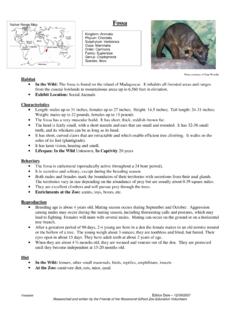Transcription of Yellow-spotted Amazon River Turtle - Rosamond …
1 YellowspottedAmazonriverturtleaaa Edition Date 8/10/2006 Researched and written by the Friends of the Rosamond Gifford Zoo Education Volunteers Yellow-spotted Amazon River Turtle Photo courtesy of Janet Wisneski Habitat In the Wild: Yellow-spotted Amazon turtles are found in northern South America, mainly in the Amazon and Orinoco River drainages, large rivers, backwaters, lagoons and flooded forests. During the flood season, they avoid fast moving waters by taking up residence in lakes and flooded forests. Exhibit Location: USS Antiquities Characteristics Length: male carapace (top shell) 8-15 inches, female carapace 15-20 inches Width: male carapace 7-13 inches, female carapace 13-18 inches Weight: male 5-10 pounds, female - 25 pounds The Podocnemis unifilis gets its name from yellow spots on the olive green to brown head, which are most obvious in young turtles, and fade to almost nothing in females, but remain present in males throughout life.
2 The head is dominated by paired frontal scales, which meet along a distinct groove between the eyes. Most turtles of this genus have 2 or 3 barbels (threadlike growths that act like organs of touch) under the chin, but the Yellow-spotted Amazon has only 1 barbel, hence the name unifilis. The carapace (top shell) is domed with a raised ridge in the center, known as a keel. The plastron (bottom shell) is yellow and sometimes has dark blotches. The front legs have 5 claws and the hind legs are webbed with 4 claws. Lifespan: In the Wild: about 20 years; In Captivity 20+ years Behaviors The Yellow-spotted Amazon River Turtle is diurnal and is most active in mid-morning and afternoon.
3 Groups of turtles can be seen basking in the sun on logs or stones in the middle of rivers and on the shore. As ectothermic (cold-blooded) animals, this behavior functions to warm their bodies. Yellow-spotted Amazon River turtles are very aquatic, only coming out of the water to bask. Enrichments at the Zoo: food items Reproduction Females congregate on and near the beach to bask for several days during the mating season. Males also congregate, but do not usually bask. Males court females by nipping at their feet and tails. About 2 weeks after mating, the female lays from 15-50 eggs in a relatively shallow nest 6-10 inches long in sandy soil.
4 The nest is then stamped flat with an open foot and loosely swept over. The eggs are laid in the peak of the dry season and the nests are sometimes destroyed by rising flood waters. The incubation period is 60-90 days. The sex of the hatchlings is determined by the temperature at which they incubate. Eggs incubated below 32 C (90 F) will hatch as males, and those incubated at above 32 C will be females. After the shell is ruptured, the young remain in the shell for several days until the yolk sac is completely absorbed. They then emerge at night, usually after rain, and begin to forage for food. Diet In the Wild: vegetable matter, grasses, fruits, leaves, carrion, mollusks At the Zoo: carrots, trout chow, crickets, aquatic carnivore diet, fruit Native Range Map Kingdom: Animalia Phylum: Chordata Subphylum: Vertebrata Class: Reptillia Order: Testudines Family: Pelomedusidae Genus: Podocnemis Species: unifilis YellowspottedAmazonriverturtleaaa Edition Date 8/10/2006 Researched and written by the Friends of the Rosamond Gifford Zoo Education Volunteers Conservation Status IUCN status Vulnerable.
5 CITES Appendix II The greatest threat to this species has been the Yekuana Indians, as they regularly consumed the meat and eggs of this species. The number of non-Indian poachers increased as demand for Turtle eggs and meat increased. Climate change can also be a threat because the sex of the offspring is determined by incubation temperature. Should the temperature rise to 34 C (93 F) for long periods of time, the ratio of males to females could be severely skewed, and a rapid rise to 36 C (97 F) could possibly eliminate males altogether. The Yekuana Indians are now trying to hunt the turtles in a way that won t decrease the population levels.
6 They have implemented a conservation program for the 12 main nesting sites along the de Ninchare River . These areas are now protected from poachers by armed guards. To help protect this species, we should refrain from buying products made from wild animal parts and buying wild-caught turtles as pets. Predators: humans, birds, snakes, large fish, frogs, mammals Did You Know?/Fun Facts The shell of a Turtle develops at quite a late stage within the egg. The shell is made up of several bony plates that grow together along the line of the ribs to form a single bony shield a bit like the bony plates that make up our own skulls.
7 Podocnemis unifilis is a side-necked Turtle . It does not pull its head and neck directly back into its shell. Instead, it tucks its head and neck under the edge (margin) of the shell to one side, curving its neck in a horizontal plane. This Turtle is also known as the yellow -headed side-necked Turtle . Sources: Bristol, Clifton & West of England Society, ( ). Yellow-spotted Amazon River Turtle . Retrieved Mar. 03, 2006, from Bristol Zoo Gardens Web site: Honolulu Zoo, ( ). Amazon Turtle . Retrieved Mar. 03, 2006, from Honolulu Zoo Web site: Wildscreen, (2004). yellow -headed side-neck Turtle . Retrieved Feb.
8 18, 2006, from ARKive Images of Life on Earth Web site: Woodland Park Zoo, (2001). yellow - spotted side-necked Turtle . Retrieved Feb. 18, 2006, from Woodland Park Zoo Web site.




